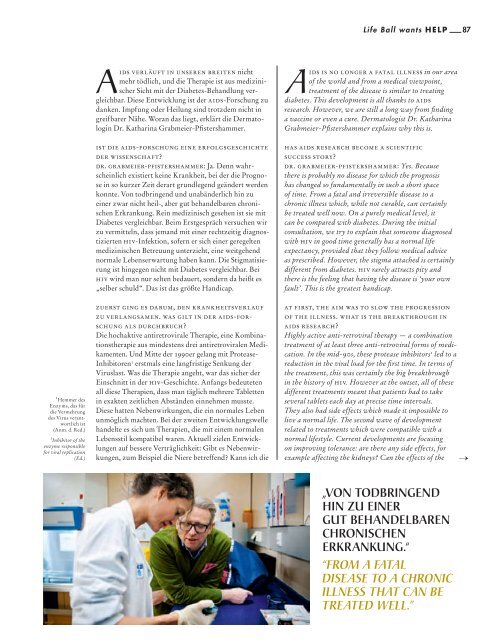You also want an ePaper? Increase the reach of your titles
YUMPU automatically turns print PDFs into web optimized ePapers that Google loves.
<strong>Life</strong> <strong>Ball</strong> wants help 87<br />
1 Hemmer des<br />
Enzyms, das für<br />
die Vermehrung<br />
des Virus verantwortlich<br />
ist<br />
(Anm. d. Red.)<br />
1 Inhibitor of the<br />
enzyme responsible<br />
for viral replication<br />
(Ed.)<br />
Aids verläuft in unseren breiten nicht<br />
mehr tödlich, und die Therapie ist aus medizinischer<br />
Sicht mit der Diabetes-Behandlung vergleichbar.<br />
Diese Entwicklung ist der aids-Forschung zu<br />
danken. Impfung oder Heilung sind trotzdem nicht in<br />
greifbarer Nähe. Woran das liegt, erklärt die Dermatologin<br />
Dr. Katharina Grabmeier-Pfistershammer.<br />
ist die aids-forschung eine erfolgsgeschichte<br />
der wissenschaft?<br />
dr. grabmeier-pfistershammer: Ja. Denn wahrscheinlich<br />
existiert keine Krankheit, bei der die Prognose<br />
in so kurzer Zeit derart grundlegend geändert werden<br />
konnte. Von todbringend und unabänderlich hin zu<br />
einer zwar nicht heil-, aber gut behandelbaren chronischen<br />
Erkrankung. Rein medizinisch gesehen ist sie mit<br />
Diabetes vergleichbar. Beim Erstgespräch versuchen wir<br />
zu vermitteln, dass jemand mit einer rechtzeitig diagnostizierten<br />
hiv-Infektion, sofern er sich einer geregelten<br />
medizinischen Betreuung unterzieht, eine weitgehend<br />
normale Lebenserwartung haben kann. Die Stigmatisierung<br />
ist hingegen nicht mit Diabetes vergleichbar. Bei<br />
hiv wird man nur selten bedauert, sondern da heißt es<br />
„selber schuld“. Das ist das größte Handicap.<br />
zuerst ging es darum, den krankheitsverlauf<br />
zu verlangsamen. was gilt in der aids-forschung<br />
als durchbruch?<br />
Die hochaktive antiretrovirale Therapie, eine Kombinationstherapie<br />
aus mindestens drei antiretroviralen Medikamenten.<br />
Und Mitte der 1990er gelang mit Protease-<br />
Inhibitoren 1 erstmals eine langfristige Senkung der<br />
Viruslast. Was die Therapie angeht, war das sicher der<br />
Einschnitt in der hiv-Geschichte. Anfangs bedeuteten<br />
all diese Therapien, dass man täglich mehrere Tabletten<br />
in exakten zeitlichen Abständen einnehmen musste.<br />
Diese hatten Nebenwirkungen, die ein normales Leben<br />
unmöglich machten. Bei der zweiten Entwicklungs welle<br />
handelte es sich um Therapien, die mit einem normalen<br />
Lebensstil kompatibel waren. Aktuell zielen Entwicklungen<br />
auf bessere Verträglichkeit: Gibt es Nebenwirkungen,<br />
zum Beispiel die Niere betreffend? Kann ich die<br />
Aids is no longer a fatal illness in our area<br />
of the world and from a medical viewpoint,<br />
treatment of the disease is similar to treating<br />
diabetes. This development is all thanks to aids<br />
research. However, we are still a long way from finding<br />
a vaccine or even a cure. Dermatologist Dr. Katharina<br />
Grabmeier-Pfistershammer explains why this is.<br />
has aids research become a scientific<br />
success story?<br />
dr. grabmeier-pfistershammer: Yes. Because<br />
there is probably no disease for which the prognosis<br />
has changed so fundamentally in such a short space<br />
of time. From a fatal and irreversible disease to a<br />
chronic illness which, while not curable, can certainly<br />
be treated well now. On a purely medical level, it<br />
can be compared with diabetes. During the initial<br />
consultation, we try to ex plain that someone diagnosed<br />
with hiv in good time gen erally has a normal life<br />
expectancy, provided that they follow medical advice<br />
as prescribed. However, the stigma attached is certainly<br />
different from diabetes. hiv rarely attracts pity and<br />
there is the feeling that having the disease is ‘your own<br />
fault’. This is the greatest handicap.<br />
at first, the aim was to slow the progression<br />
of the illness. what is the breakthrough in<br />
aids research?<br />
Highly active anti-retroviral therapy — a combination<br />
treatment of at least three anti-retroviral forms of medication.<br />
In the mid-90s, these protease inhibitors 1 led to a<br />
reduction in the viral load for the first time. In terms of<br />
the treatment, this was certainly the big breakthrough<br />
in the history of hiv. However at the outset, all of these<br />
different treatments meant that patients had to take<br />
several tablets each day at precise time intervals.<br />
They also had side effects which made it impossible to<br />
live a normal life. The second wave of development<br />
related to treatments which were compatible with a<br />
normal lifestyle. Current developments are focusing<br />
on improving tolerance: are there any side effects, for<br />
example affecting the kidneys? Can the effects of the<br />
→<br />
„von todbringend<br />
hin zu einer<br />
gut behandelbaren<br />
chronischen<br />
erkrankung.“<br />
“from a fatal<br />
disease to a chronic<br />
illness that can be<br />
treated well.”


